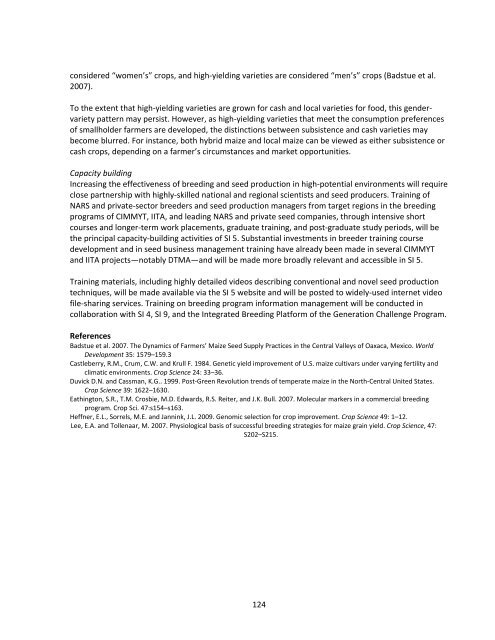Download - Maize
Download - Maize
Download - Maize
You also want an ePaper? Increase the reach of your titles
YUMPU automatically turns print PDFs into web optimized ePapers that Google loves.
considered “women’s” crops, and high‐yielding varieties are considered “men’s” crops (Badstue et al.<br />
2007).<br />
To the extent that high‐yielding varieties are grown for cash and local varieties for food, this gendervariety<br />
pattern may persist. However, as high‐yielding varieties that meet the consumption preferences<br />
of smallholder farmers are developed, the distinctions between subsistence and cash varieties may<br />
become blurred. For instance, both hybrid maize and local maize can be viewed as either subsistence or<br />
cash crops, depending on a farmer’s circumstances and market opportunities.<br />
Capacity building<br />
Increasing the effectiveness of breeding and seed production in high‐potential environments will require<br />
close partnership with highly‐skilled national and regional scientists and seed producers. Training of<br />
NARS and private‐sector breeders and seed production managers from target regions in the breeding<br />
programs of CIMMYT, IITA, and leading NARS and private seed companies, through intensive short<br />
courses and longer‐term work placements, graduate training, and post‐graduate study periods, will be<br />
the principal capacity‐building activities of SI 5. Substantial investments in breeder training course<br />
development and in seed business management training have already been made in several CIMMYT<br />
and IITA projects—notably DTMA—and will be made more broadly relevant and accessible in SI 5.<br />
Training materials, including highly detailed videos describing conventional and novel seed production<br />
techniques, will be made available via the SI 5 website and will be posted to widely‐used internet video<br />
file‐sharing services. Training on breeding program information management will be conducted in<br />
collaboration with SI 4, SI 9, and the Integrated Breeding Platform of the Generation Challenge Program.<br />
References<br />
Badstue et al. 2007. The Dynamics of Farmers’ <strong>Maize</strong> Seed Supply Practices in the Central Valleys of Oaxaca, Mexico. World<br />
Development 35: 1579–159.3<br />
Castleberry, R.M., Crum, C.W. and Krull F. 1984. Genetic yield improvement of U.S. maize cultivars under varying fertility and<br />
climatic environments. Crop Science 24: 33–36.<br />
Duvick D.N. and Cassman, K.G.. 1999. Post‐Green Revolution trends of temperate maize in the North‐Central United States.<br />
Crop Science 39: 1622–1630.<br />
Eathington, S.R., T.M. Crosbie, M.D. Edwards, R.S. Reiter, and J.K. Bull. 2007. Molecular markers in a commercial breeding<br />
program. Crop Sci. 47:s154–s163.<br />
Heffner, E.L., Sorrels, M.E. and Jannink, J.L. 2009. Genomic selection for crop improvement. Crop Science 49: 1–12.<br />
Lee, E.A. and Tollenaar, M. 2007. Physiological basis of successful breeding strategies for maize grain yield. Crop Science, 47:<br />
S202–S215.<br />
124

















